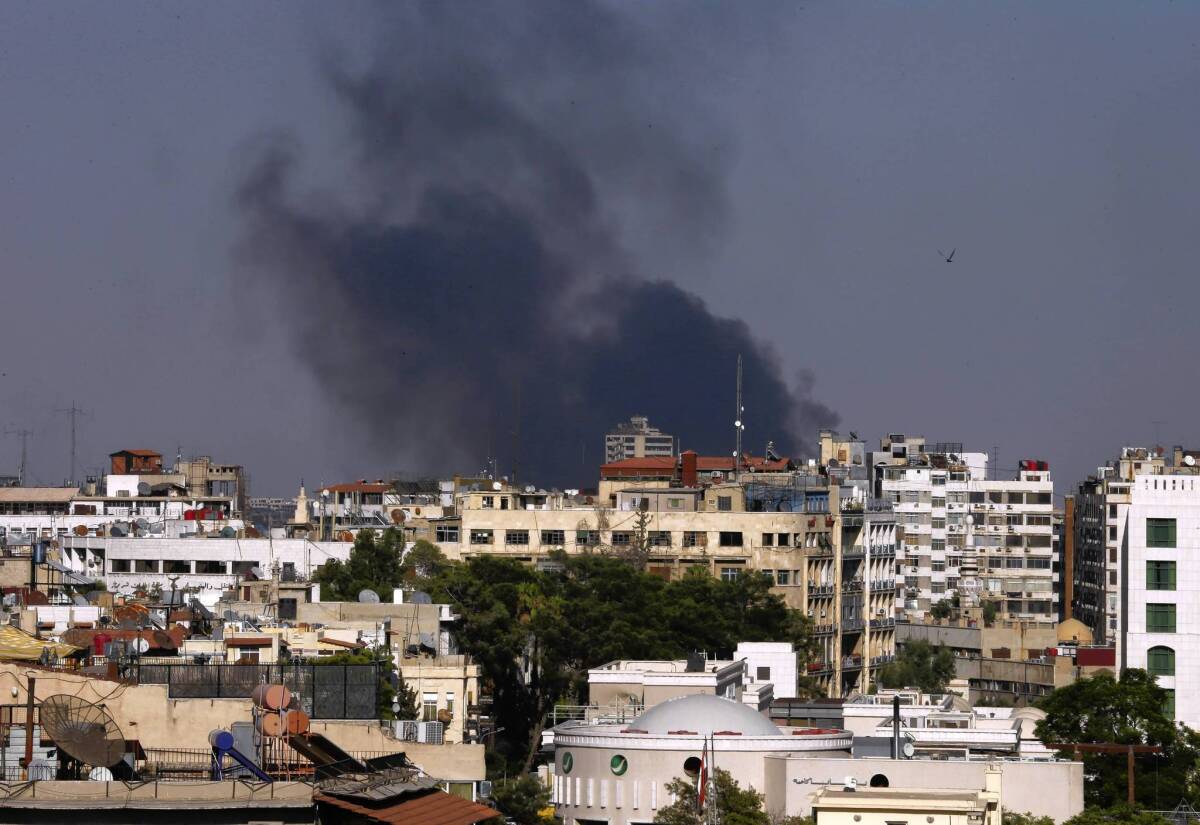Siege of Syrian capital’s districts, suburbs cuts off food, medicine

CAIRO — In one of the many videos from Wednesday’s alleged chemical attack in Syria, a father holds the lifeless body of his daughter. On the ground at his feet lay the body of another daughter.
“Before, I put out food for her and she said, ‘Dad, today is not my turn for food, it’s my siblings’ turn,’” the man said, referring to bread and food shortages in their town caused by the government’s siege. “And the hunger, what are we supposed to do?”
The grief-stricken father was talking about the rebel-controlled Ghouta Sharqia area, suburbs east of Damascus, where a months-long siege has prevented food, medicine and other aid from reaching the towns outside the capital. Activists and residents say the zone is facing extreme food and medicine shortages that have been exacerbated by Wednesday’s alleged attack.
In the first few hours after the alleged attack, field hospitals reportedly ran out of atropine and oxygen to treat victims. Since then, smugglers have managed to bring in only a small amount of medicine, Mohammed Salah Deen, an activist in Zamalka, one of the towns.
Shelling and clashes were continuing Sunday in the area, residents reported.
The eastern suburbs are not the only areas around the capital that have been cut off. Southern suburbs as well as 14 opposition-controlled neighborhoods in Damascus are under siege, activists and aid groups say.
More than 1.2 million people in urgent need of assistance are living in hard-to-reach areas amid deteriorating conditions around the capital, according to the United Nations.
“The situation is indescribable except that it is a full-blown humanitarian crisis,” said Rami Sayid, a resident of the Yarmouk refugee camp, one of the south Damascus neighborhoods that have been under siege for more than a month. “For 40 days till now, not even a loaf of bread has been allowed to come in.”
On Aug. 19, a 6-month-old girl died because her mother was stuck outside the neighborhood after leaving to get food and there was no milk or formula to feed her, Sayid said by Skype.
Residents have been breaking into the empty homes of those who have fled the area and rummaging through refrigerators and cupboards, he said, often finding only spoiled food because there has been no electricity for months, but eating it nonetheless.
“We hold the United Nations responsible for the humanitarian crisis and starvation that is going on,” he said, adding that the previous day was the first time activists in Yarmouk were contacted by a representative from a U.N. aid agency who asked to be put in touch with needy families.
The World Food Program had delivered rations for half a million people in the suburbs in July, said Clare Doyle, a deputy spokeswoman for the U.N. Office for the Coordination of Humanitarian Affairs. But several areas remain out of reach and others became unreachable last month, such as the neighborhoods of Tadamon and Hajar Aswad.
Doyle said the U.N. Relief and Works Agency, which has an office in Yarmouk, still provides services to Palestinian refugees but the movement of civilians in and out of the camp is restricted.
The United Nations has for months been unable to deliver aid in Damascus suburbs where families “are subject to immense suffering,” the U.N. has said, despite repeated promises from the Syrian government to grant access.
Since March, U.N. aid agencies had made a number of unsuccessful attempts to reach the town of Moadamyeh, southwest of Damascus. The agencies submitted three official requests to the government and aid deliveries were rescheduled seven times. Finally, the World Food Program made two attempts to provide aid; both convoys reached the last checkpoint before the town but had to turn back because of “hostilities.”
“This situation does not reflect the repeated pledges by the authorities to allow humanitarian actors to access all areas in Syria where there is need to deliver humanitarian assistance,” the U.N. said in a June 12 statement.
In early August, when government forces ambushed and killed more than 60 rebel fighters, opposition sources said the men were attempting to deliver flour and medicine to Ghouta Sharqia. A rebel spokesman at the time said it was the third unsuccessful attempt to deliver aid to the towns.
Since the beginning of the siege, a sign had been hung up at the entrance of the Yarmouk camp that reads “Hunger or submission,” said Luay Dimashqi, who lives in the adjacent Tadamon neighborhood.
Dimashqi said the siege on the southern neighborhoods, much like that on the suburbs to the east and south, is part of an effort by the government to storm the rebel-controlled areas.
Field hospitals have run out of medicines to treat malnutrition and dehydration, he said, and four people have reportedly died of starvation.
One crossing into the besieged neighborhoods is opened from time to time for an hour or two, but people are not allowed to bring anything in, he said. Those who attempt to sneak in food are usually caught and detained, he said.
More to Read
Sign up for Essential California
The most important California stories and recommendations in your inbox every morning.
You may occasionally receive promotional content from the Los Angeles Times.











